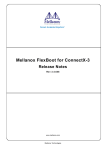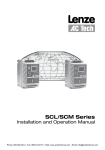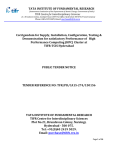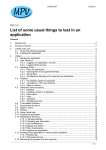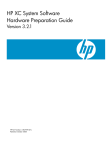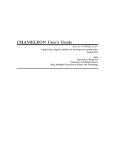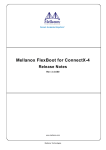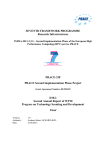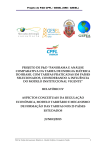Download New CSC computing resources
Transcript
New CSC computing resources Atte Sillanpää, Nino Runeberg CSC – IT Center for Science Ltd. Outline CSC at a glance New Kajaani Data Centre Finland’s new supercomputers – Sisu (Cray XC30) – Taito (HP cluster) CSC resources available for researchers CSC presentation 2 CSC’s Services Funet Services Computing Services Application Services Data Services for Science and Culture Information Management Services Universities Polytechnics Ministries Public sector Research centers Companies FUNET and Data services FUNET – Connections to all higher education institutions in Finland and for 37 state research institutes and other organizations – Network Services and Light paths – Network Security – Funet CERT – eduroam – wireless network roaming – Haka-identity Management – Campus Support – The NORDUnet network Data services – Digital Preservation and Data for Research Data for Research (TTA), National Digital Library (KDK) International collaboration via EU projects (EUDAT, APARSEN, ODE, SIM4RDM) – Database and information services Paituli: GIS service Nic.funet.fi – freely distributable files with FTP since 1990 CSC Stream Database administration services – Memory organizations (Finnish university and polytechnics libraries, Finnish National Audiovisual Archive, Finnish National Archives, Finnish National Gallery) 4 Current HPC System Environment Name Louhi Vuori Type Cray XT4/5 HP Cluster DOB 2007 2010 Nodes 1864 304 CPU Cores 10864 3648 Performance ~110 TFlop/s 34 TF Total memory ~11 TB 5 TB Interconnect Cray SeaStar 3D Torus QDR IB Fat tree CSC presentation 5 CSC Computing Capacity 1989–2012 Standardized processors Cray XC30 max. capacity (80%) capacity used 10000 Cray XT5 1000 Cray T3E expanded Cray T3E (224 proc) (192 proc) 100 HP CP4000BL Proliant 465c DC AMD IBM SP Power3 Compaq Alpha cluster (Clux) SGI upgrade Convex 3840 SGI Origin 2000 IBM upgrade SGI R4400 SGI upgrade Murska decommissioned 6/2012 Sun Fire 25K IBM SP2 IBM SP1 HP Proliant SL230s HP DL 145 Proliant 10 Cray X-MP/416 HP CP4000 BL Proliant Cray XT4 QC 6C AMD Cray T3E expanded (512 proc) Cray C94 1 Cray XT4 DC IBM eServer Cluster 1600 Two Compaq Alpha Servers (Lempo and Hiisi) Federation HP switch upgrade on IBM Cray T3E decommissioned 12/2002 Clux and Hiisi decommissioned 2/2005 Cray T3E IBM SP2 decommissioned (64 proc) 1/1998 Convex C220 1989 1990 1991 1992 1993 1994 1995 1996 1997 1998 1999 2000 2001 2002 2003 2004 2005 2006 2007 2008 2009 2010 2011 2012 50. Top500 rating 1993–2012 100. The Top500 lists http://www.top500.org/ were started in 1993. Cray T3E IBM eServer p690 Cray XT4/XT5 Cray XC30 150. 250. HP Proliant SL230s HP Proliant 465c DC 200. SGI Power Challenge IBM SP2 SGI Origin 2000 300. 350. Cray C94 400. HP Proliant 465c 6C IBM SP1 Digital AlphaServer 450. 500. IBM SP Power3 Cray X-MP Convex C3840 CSC presentation 6 THE NEW DATACENTER CSC presentation 7 CSC presentation 8 CSC presentation 9 Power distribution (FinGrid) Last site level blackout in the early 1980s CSC presentation CSC started ITI Curve monitoring early Feb-2012 10 The machine hall CSC presentation 11 Sisu (Cray) supercomputer housing CSC presentation 12 SGI Ice Cube R80, hosting Taito (HP) CSC presentation 13 SGI Ice Cube R80 CSC presentation 14 Starting with one head unit (Vestibule) and two expansion modules ; extra capacity can be increased by introducing more expansion units. Thanks to dozens of automated cooling fans, the energy needed for cooling can be adjusted very accurately as IT capacity is increased gradually. Internal temperature setpoint 27OC (ASHRAE) and occasionally ASHRAE tolerated (27-30OC) during possible summer heat waves. As long as outdoor temperatures are less than 28OC, Unit does nothing but free cooling. During heat waves extra water and some chillers possibly needed. During winter, the exhaust (warm) air is re-circulated to warm up the incoming air. CSC presentation 15 Data center specification 2.4 MW combined hybrid capacity 1.4 MW modular free air cooled datacenter – Upgradable in 700 kW factory built modules – Order to acceptance in 5 months – 35 kW per extra tall racks – 12 kW common in industry – PUE forecast < 1.08 (pPUEL2,YC) 1MW HPC datacenter – Optimised for Cray super & T-Platforms prototype – 90% Water cooling CSC presentation 16 CSC NEW SUPERCOMPUTERS CSC presentation 17 Overview of New Systems Phase 1 Cray Deployment December CPU Phase 2 HP Cray HP Now Mid 2014 Mid 2014 Intel Sandy Bridge 8 cores @ 2.6 GHz Next generation processors Interconnect Aries FDR InfiniBand (56 Gbps) Cores 11776 9216 ~40000 ~17000 Tflops 244 (2x Louhi) 180 (5x Vuori) 1700 (16x Louhi) 515 (15x Vuori) Tflops total CSC presentation 424 (3.6x Louhi) Aries EDR InfiniBand (100 Gbps) 2215 (20.7x Louhi) 18 IT summary Cray XC30 supercomputer (Sisu) – Fastest computer in Finland – Phase 1: 385 kW, 244 Tflop/s – Very high density, large racks T-Platforms prototype (Phase 2) – Very high density hot-water cooled rack – Intel processors, Intel and NVIDIA accelerators – Theoretical 400 TFlops performance CSC presentation 19 IT summary cont. HP (Taito) – 1152 Intel CPUs – 180 TFlop/s – 30 kW 47 U racks HPC storage – 3 PB of fast parallel storage – Supports Cray and HP systems CSC presentation 20 Features Cray XC30 – Completely new system design Departure from the XT* design (2004) – First Cray with Intel CPUs – High-density water-cooled chassis ~1200 cores/chassis – New ”Aries” interconnect HP Cluster – Modular SL-series systems – Mellanox FDR (56 Gbps) Interconnect CSC presentation 21 CSC new systems: What’s new? Sandy Bridge CPUs – 4->8 cores/socket – ~2.3x Louhi flops/socket 256-bit SIMD instructions (AVX) Interconnects – Performance improvements Latency, bandwidth, collectives One-sided communication – New topologies Cray: ”Dragonfly”: Islands of 2D Meshes HP: Islands of fat trees CSC presentation 22 Cray Dragonfly Topology All-to-all network between groups 2 dimensional all-to-all network in a group Optical uplinks to inter-group net Source: Robert Alverson, Cray Hot Interconnects 2012 keynote CSC presentation 23 Cray environment Typical Cray environment Compilers: Cray, Intel and GNU Debuggers – Totalview, tokens shared between HP and Cray Cray mpi Cray tuned versions of all usual libraries SLURM Module system similar to Louhi Default shell now bash (previously tcsh) CSC presentation 24 HP Environment Compilers: Intel, GNU MPI libraries: Intel, mvapich2, OpenMPI Batch queue: SLURM New more robust module system – Only compatible modules shown with module avail – Use module spider to see all Default shell now bash (used to be tcsh) Disk system changes CSC presentation 25 Core development tools Intel XE Development Tools – Compilers C/C++ (icc), Fortran (ifort), Cilk+ – Profilers and trace utilities Vtune, Thread checker, MPI checker – MKL numerical library – Intel MPI library (only on HP) Cray Application Development Environment GNU Compiler Collection TotalView debugger CSC presentation 26 Performance of numerical libraries DGEMM 1000x1000 Single-Core Performance 30.00 Turbo Peak (when only 1 core is used) @ 3.5GHz * 8 Flop/Hz 25.00 Peak @ 2.7GHz * 8 Flop/Hz GFlop/s 20.00 Sandy Bridge 2.7GHz Opteron Barcelona 2.3GHz (Louhi) 15.00 Peak @ 2.3GHz * 4 Flop/Hz 10.00 5.00 0.00 ATLAS 3.8 RedHat 6.2 RPM ATLAS 3.10 ACML 5.2 Ifort 12.1 matmul MKL 12.1 LibSci ACML 4.4.0 MKL 11 MKL the best choice on Sandy Bridge, for now. (On Cray, LibSci will likely be a good alternative) CSC presentation 27 Compilers, programming Intel – Intel Cluster Studio XE 2013 – http://software.intel.com/en-us/intel-clusterstudio-xe GNU – GNU-compilers, e.g. GCC 4.7.2. – http://gcc.gnu.org/ Intel can be used together with GNU – E.g. gcc or gfortran + MKL + IntelMPI mvapich2 MPI-library also supported – It can be used that Intel or GNU CSC presentation 28 Available applications Ready: – Taito: Gromacs, NAMD, Gaussian, Turbomole, Amber, CP2K, Elmer, VASP – Sisu: Gromacs, GPAW, Elmer, VASP CSC offers ~240 scientific applications – Porting them all is a big task – Most if not all (from Vuori) should be available Some installations upon request – Do you have priorities? CSC presentation 29 Porting strategy At least recompile – Legacy binaries may run, but not optimally – Intel compilers preferred for performance – Use Intel MKL or Cray LibSci (not ACML!) http://software.intel.com/sites/products/mkl/ – Use compiler flags (i.e. -xhost -O2 (includes –xAVX)) Explore optimal thread/task placement – Intra-node and internode Refactor the code if necessary – OpenMP/MPI workload balance – Rewrite any SSE assembler or intrinsics HPC Advisory Council has best practices for many codes – http://www.hpcadvisorycouncil.com/subgroups_hpc_works.php During (and after) pilot usage, share your makefiles and optimization experiences in the wiki http://software.intel.com/sites/default/files/m/d/4/1/d/8/optaps_cls.pdf http://software.intel.com/sites/default/files/m/d/4/1/d/8/optaps_for.pdf CSC presentation 30 Modules Some software installations are conflicting with each other – For example different versions of programs and libraries Modules facilitate the installation of conflicting packages to a single system – User can select the desired environment and tools using module commands – Can also be done "on-the-fly" CSC presentation 31 Taito module system Old module system has not been actively maintained for a long time Robert McClay has written a new and modified version from a scratch – More robust – Slightly different internal logic – Actively developed (bug fixes, new features like support for accelerators, etc.) CSC presentation 32 Key differencies (Taito vs. Vuori) module avail shows only those modules that can be loaded to current setup (no conflicts or extra dependencies) – Use module spider to list all installed modules and solve the conflics/dependencies No PrgEnv- modules – Changing the compiler module switches also MPI and other compiler specific modules CSC presentation 33 Disks at Espoo CSC presentation 34 Disks at Kajaani sisu.csc.fi taito.csc.fi login nodes login nodes Your workstation SUI iRODS client compute nodes compute nodes $WRKDIR New tape $ARCHIVE in Espoo $HOME $TMPDIR $TMPDIR $TMPDIR $TMPDIR $TMPDIR iRODS interface disk cache icp, iput, ils, irm $USERAPPL icp $HOME/xyz CSC presentation 35 Disks 2.4 PB on DDN – New $HOME directory (on Lustre) – $WRKDIR (not backed up), soft quota ~ 5 TB $ARCHIVE ~1 - 5 TB / user, common between Cray and HP (@ Espoo) Disk space through IDA – – – – 1 PB for Univerisities 1 PB for Finnish Academy (SA) 1 PB to be shared between SA and ESFRI Additional 3 PB available later on /tmp (around 2 GB) to be used for compiling codes CSC presentation 36 Moving files, best practices tar & bzip first rsync, not scp – rsync -P [email protected]:/tmp/huge.tar.gz . Blowfish may be faster than AES (CPU bottleneck) Funet FileSender (max 50 GB) – https://filesender.funet.fi – Files can be downloaded also with wget Coming: iRODS, batch-like process, staging IDA CSC can help to tune e.g. TCP/IP parameters – http://www.csc.fi/english/institutions/funet/networkservices/pert FUNET backbone 10 Gbit/s CSC presentation 37 ARCHIVE, dos and don’ts Don’t put small files in $ARCHIVE – – – – Small files waste capacity Less than 10 MB is small Keep the number of files small Tar and bzip files Time to retrieve (any) file 3 min + 1s/10MB Don’t use $ARCHIVE for incremental backup (store, delete/overwrite, store, …) – Space on tape is not freed up until months or years! Maximum file size 300GB Default quota 2 TB per user, new likely up to 5 TB New ARCHIVE being installed, consider if you really need all your old files. Transfer from old to new needed. CSC presentation 38 Use profiles Taito (HP) Serial and parallel upto about 256 cores (TBD) Sisu (Cray XE30) Parallel up to thousands of cores Scaling tests CSC presentation 39 Queue/server policies Longrun queue has drawbacks – Shorter jobs can be chained Apps that can’t restart/write checkpoint? – Code you use to run very long jobs? Large memory jobs to Hippu/HP big memory nodes – Think about memory consumption Minimum job size in Cray – Your input? CSC presentation 40 Documentation and support User manual being built, FAQ here: – https://datakeskus.csc.fi/en/web/guest/faq-knowledge-base – Pilot usage during acceptance tests User documetation’s link collection – http://www.csc.fi/english/research/sciences/chemistry/intro First HP Workshop materials: – http://www.csc.fi/english/csc/courses/archive/taito-workshop Porting project – All code needs to be recompiled – Help available for porting your code List of first codes, others added later, some upon request User accounts – HP: recent vuori users moved automatically – Cray: recent Louhi users moved automatically – Others: request from [email protected] with current contact information CSC presentation 41 Grand Challenges Normal GC call out in the end of December 2012 – new CSC resources available for a year – no bottom limit for number of cores Special GC call (mainly for Cray) out in the end of December 2012 – possibility for short (day or less) runs with the whole Cray – What do you need? Remember also PRACE/DECI – http://www.csc.fi/english/csc/news/customerinfo/DECI10call open CSC presentation 42 Accelerators Add-on processors Graphics Processing Units – de facto accelerator technology today Fast memory Many lightweight cores Influencing general purpose computing Accelerator Memory CPU(s) PCIe bus CSC presentation InfiniBand node(s) 43 Evolution of CPU and GPU performance Memory bandwidth Energy efficiency 180.00 16 160.00 14 140.00 12 Peak GFlop/s watt Gbyte/s 120.00 100.00 80.00 60.00 10 8 GPU CPU 6 4 40.00 2 20.00 0.00 0 2008 2009 2010 2011 2012 CSC presentation 44 Future directions in parallel programming MPI-3 standard being finalized – Asynchronous collective communication etc. Partitioned Global Address Space (PGAS) – Data sharing via global arrays – Finally starting to see decent performance – Most mature: Unified Parallel C, Co-Array Fortran (in Fortran 2008), OpenSHMEM Task Dataflow -based parallel models – Splits work into a graph (DAG) of tasks – SmpSs, DAGUE, StarPU CSC presentation 45 CSC RESOURCES AVAILABLE FOR RESEARCHERS CSC presentation 46 Currently available computing resources Massive computational challenges: Louhi – > 10 000 cores, >11TB memory – Theoretical peak performance > 100 Tflop/s HP-cluster Vuori – Small and medium-sized tasks – Theoretical peak performance >40 Tflop/s Application server Hippu – Interactive usage, without job scheduler – Postprocessing, e.g. vizualization FGI CSC presentation 47 Novel resources at CSC Production (available for all Finnish researchers) – Vuori: 8 Tesla GPU nodes – FGI: 88 GPUs (44 Tesla 2050 + 44 Tesla 2090) GPU nodes located at HY, Aalto, ÅA, TTY Testing (primarily for CSC experts) – Tunturi: Sandy Bridge node, cluster Porting to AVX instruction set – Mictest: Intel MIC prototype node Several beta cards CSC presentation 48 Old capacity decommissions Louhi decommissioned after new Cray is up and running – quite probably fairly short overlap Vuori decommission at end of 2013 Think ahead of data transfers CSC presentation 49 CSC cloud services CSC presentation 50 Three service models of cloud computing Software SaaS Operating systems PaaS Computers and networks IaaS CSC presentation 51 Example: Virtualization in Taito Taito cluster: two types of nodes, HPC and cloud HPC node HPC node Cloud node Host OS: RHEL Virtual machine • Guest OS: Ubuntu Virtual machine • Guest OS: Windows Cloud node CSC presentation 52 Traditional HPC vs. IaaS Traditional HPC environment Cloud environment Virtual Machine Operating system Same for all: CSC’s cluster OS Chosen by the user Software installation Done by cluster administrators Customers can only install software to their own directories, no administrative rights Installed by the user The user has admin rights User accounts Managed by CSC’s user administrator Managed by the user Security e.g. software patches CSC administrators manage the common software and the OS User has more responsibility: e.g. patching of running machines Running jobs Jobs need to be sent via the cluster’s Batch Scheduling System (BSS) The user is free to use or not use a BSS Environment changes Changes to SW (libraries, compilers) happen. The user can decide on versions. Snapshot of the environment Not possible Performance Can save as a Virtual Machine image Performs well for a variety of tasks CSC presentation Very small virtualization overhead for most tasks, heavily I/O bound and MPI tasks affected more 53 Cloud: Biomedical pilot cases Several pilots (~15) Users from several institutions, e.g. University of Helsinki, Finnish Institute for Molecular Medicine and Technical University of Munich Many different usage models, e.g.: Extending existing cluster Services run on CSC IaaS by university IT department for end users (SaaS for end users) CSC presentation 54 NX for remote access Optimized remote desktop access – Near local speed application responsiveness over high latency, low bandwidth links Customized launch menus offer direct access CSC supported applications Working session can saved and restored at the next login Further information: http://www.csc.fi/english/research/software/freenx CSC presentation 55 NX screenshot CSC presentation 56 Customer training Taito (HP) – Taito cluster workshop 28.-30.11.2012 Materials – Next one likely in January 2013 Sisu (Cray) – February 26 - March 1, 2013 (mostly for pilot users, open for everyone) – May 14 - May 17 (for all users, a PATC course, i.e. expecting participants from other countries too) CSC presentation 57 How to prepare for new systems Participate in system workshops Try Intel/GNU compiler in advance, PGI upon request Check if your scripts/aliases need fixing (bash) A lot of resources available in the beginning: prepare ahead what to run! The traditional wisdom about good application performance will still hold – Experiment with all compilers and pay attention on finding good compiler optimization flags – Employ tuned numerical libraries wherever possible – Experiment with settings of environment variable that control the MPI library – Mind the I/O: minimize output, checkpoint seldom CSC presentation 58 Sisu&Taito vs. Louhi&Vuori vs. FGI vs. Local Cluster Availability CPU Sisu&Taito (Phase 1) Louhi&Vuori 1Q/2Q 2013 Available Intel Sandy AMD Opteron 2.3 GHz Barcelona and 2.7 Bridge, 2 x 8 GHz Shanghai / 2.6 cores, 2.6 GHz, GHz AMD Opteron Xeon E5-2670 and Intel Xeon FGI Taygeta Available Available Intel Xeon, 2 x 6 cores, 2.7 GHZ, X5650 Interconnect Aries / FDR IB SeaStar2 / QDR IB Cores 11776 / 9216 10864 / 3648 7308 360 2 / 4 GB 16x 256GB/node 1 / 2 / 8 GB 2 / 4 / 8 GB 4 GB Tflops 244 / 180 102 / 33 95 4 GPU nodes in Phase2 -/8 88 - Disc space 2.4 PB 110 / 145 TB 1+ PB 0.8 TB59 RAM/core CSC presentation QDR IB Conclusions Performance comparison Larger memory Collective communication 60 taito 50 Sisu (estimated) FGI 40 ns/day – Per core performance ~2 x compared to Vuori/Louhi – Better interconnects enhance scaling dhfr benchmark, 30k atoms, PME, Gromacs vuori 30 louhi 20 10 0 0 10 20 30 40 cores CSC presentation 60 Round robin Nino Runeberg, Atte Sillanpää, CSC – IT Center for Science Ltd. Round robin Your research interest, how CSC can help? Queue length: 3 days enough? – Codes that can’t checkpoint? – Other reasons? Is memory an issue for you? – 256 GB/nodes usage policy? Special libraries/tools? Special Grand Challenge needs? Need to move a lot of files? (from where?) Do you need GPGPU/MICs? Which code? CSC presentation 62
































































